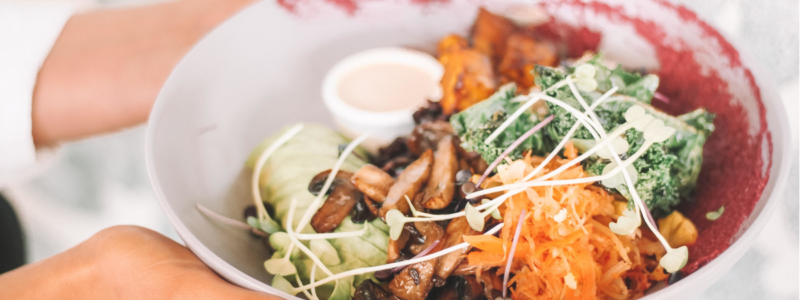Have you reduced the amount of meat you eat? If so, you’re following a flexitarian diet – whether you meant to or not!
It’s an increasingly popular approach to nutrition. The number of flexitarians in the UK has grown by 21%, according to Kantor. Some estimates suggest 50% of the population could be flexitarian by 2025.
The beauty of a flexitarian diet is that it’s relatively easy to follow, without making any major life changes. You prioritise plant-based foods, but also indulge in meat every once in a while.
Simple, right? Of course, there are some complexities and questions within that, such as the role of dairy and how much meat you should include.
Whether you’re already an accidental flexitarian or you’re interested in making the switch, here’s what you need to know to decide if it’s the right approach for you.
What is a “flexitarian”?
A combination of the words “vegetarian” and “flexible”, a “flexitarian” is someone who eats primarily plant-based foods while allowing meat and other animal products in moderation.
The term and the concept were popularised in 2008 by registered dietician Dawn Jackson Blatner and her book The Flexitarian Diet. The idea behind the diet is that you can still get all the health benefits of eating a plant-based diet without avoiding meat 100% of the time. Eliminating the all-or-nothing mentality can go a long way toward making the diet feel more sustainable. There are also several ways to approach a flexitarian diet, so it won’t look the same for everyone. As your lifestyle and dietary needs and preferences shift, your flexitarianism can too.
What you can and can’t eat
Flexitarianism is all about losing hard and fast restrictions and prioritising healthy choices. From plenty of fruits and vegetables to whole grains and lean proteins from beans, lentils, nuts, eggs and some dairy, there is plenty of variety in a flexitarian diet.
While there is technically nothing you can’t eat on a flexitarian diet, it’s still important to limit processed foods and excessive amounts of sugar. When it comes to meat, it’s all up to you. For some, a quality steak a couple of times a year is sufficient. For others, indulging in comfort food on holidays is their go-to. You can also choose to leave certain foods out entirely — like dairy — while others incorporate yoghurt or cheese for their protein-rich benefits.
The bottom line is that the specifics are up to you. Finding what works will be an ongoing process as you get more comfortable with plant-based cooking and explore your options.
The benefits of a flexitarian diet
The benefits of a 100% plant-based diet are a hot topic these days. But for many people, simply aiming for more plant foods and decreasing animal products can also make a significant impact on long-term health. Here are some of the benefits of adopting a flexitarian mindset:
- It diversifies your nutrition: A diet full of a wide variety of fruits and vegetables is more likely to be nutrient-dense. At the same time, when you’re filling your plate with nutrient-dense plant-based foods, there will be less room for processed sugars and carbs.
- It’s mentally sustainable: Restricting every craving can lead to diet burnout. With a more flexible approach, you can allow yourself to indulge sometimes without feeling like you’ve broken any rules.
- It’s budget-friendly: You’ll notice a big change in your shopping bill if you’re staying out of the meat aisle. Plant-based sources of protein like beans, lentils and tofu can be just as filling as meat and can go a lot further.
- It’s good for the environment: Per gram of protein, beef has eight times the greenhouse gas emissions of chicken and 25 times that of tofu. Consuming fewer animal products in favour of plants can help you do your part for the environment.
- It can improve your health: A flex diet is naturally rich in fibre and healthy fats, which can reduce the risk of heart disease and help manage Type 2 diabetes.
How to switch to a flexitarian diet
If you’re used to eating a meat-heavy diet and worried about making the switch, try to look at it as a gradual transition instead. Pick a couple of days a week to experiment with plant-based meals. Once you get the hang of a few swaps, you’ll start to naturally gravitate towards more plant-based recipes and incorporate more fruits and vegetables into your diet.
Here are just a few ideas for cutting back on meat in favour of plants:
- Replace half the meat in your usual curry recipe with cauliflower, broccoli or chickpeas
- Add beans or falafel to your salad instead of chicken
- Make your own burgers at home with half ground beef, half mushrooms
- Experiment with substituting lentils into your favourite dishes (for example, this recipe for lentil shepherd’s pie)
- Grill, fry, bake or scramble up some tofu to increase your protein intake for the day
Enjoy plant-based options at David Lloyd Clubs
We know the power of plants for fuelling up before and after a workout, which is why we’ve added a range of plant-based items to our menus. Check out all the delicious options we have to offer and let us know if there are any dishes you’d like to see!
Find a club



